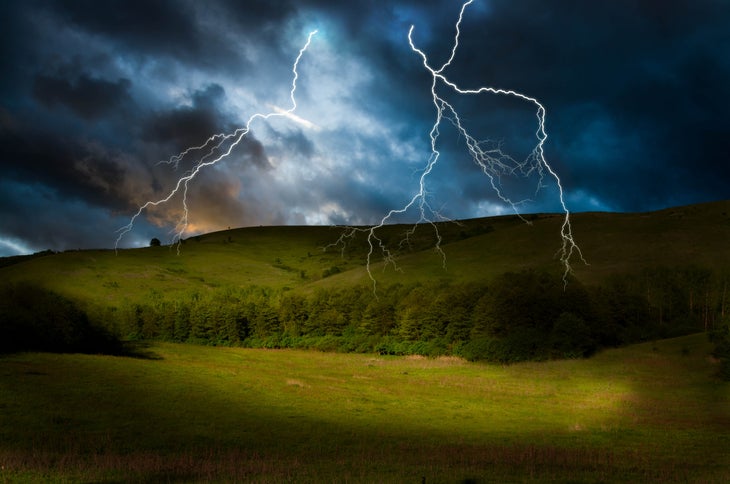Products You May Like
Get full access to Outside Learn, our online education hub featuring in-depth fitness, nutrition, and adventure courses and more than 2,000 instructional videos when you sign up for Outside+
Sign up for Outside+ today.
When it comes to wilderness survival, there’s lots of advice out there on making it out alive. But not all of it is good advice. These common survival myths have wormed their way into the public consciousness, but it’s time to set the record straight.
Myth: Don’t move if you get stuck in quicksand, or you’ll sink deeper.
While thrashing wildly might not get you anywhere, it’s safe to move in quicksand—in fact, it’s the only way you’ll get free. Move slowly to create space for water to flow in between the sand and your limb, or insert a trekking pole to loosen the sand if you have one. Lean back (you’ll float on the surface), and slowly wiggle your way out.
Myth: Hypothermia only occurs in cold weather.
Hypothermia, when a person’s core body temperature dips dangerously below the normal 98°F, is a danger in severe cold, but it can happen other times, too.
“You can alter your temperature through other means such as wind chill (convection), rain (evaporation), and coming in contact with the ground (conduction),” says Josh MacMillan, Assistant Director of Education at SOLO Wilderness Medicine Schools. “All of these processes will increase heat loss creating the potential for hypothermia in a warm environment.”
Exhaustion, blood loss, and severe injury can put a person at increased risk for hypothermia even when it’s hot out.
Myth: If you touch a person who has been struck by lightning, you’ll get electrocuted.

There’s no truth to this old wives’ tale. A person who has been struck by lightning can’t shock you, and they’ll need medical attention. If it’s safe to approach the person, check for a pulse, and administer CPR if necessary. Lightning strike victims will need to be evacuated right away and seek medical attention.
Myth: Alcohol or hydrogen peroxide are best for cleaning out a wound.
In many cases, clean water is the best method for irrigating open cuts—alcohol and peroxide aren’t very effective in the short term, and can even damage tissue. According to emergency and wilderness medicine expert Dr. Christopher Tedeschi, pressure and volume are the keys to wound irrigation.
“Best is to irrigate a wound with water, and lots of it, ideally with some pressure,” he says. “Try putting clean water in a plastic bag that can be squeezed, and cutting a little hole in the bottom corner.”
Myth: Don’t move someone if you suspect they’ve suffered a spinal cord injury.
While some of us have learned that moving an injured person can cause more damage, leaving them in place can be even worse. “The way we approach spinal immobilization has changed a ton over the past few years,” says Tedeschi. “There’s little to no good scientific evidence to suggest that immobilizing the C-spine [neck region] helps to manage the patient in the field, or that it affects patient outcomes.”
According to Tedeschi, assessing potential spinal injuries is all about risk-benefit analysis. When it comes to the patient’s safety and comfort, moving them is often critical. Lifting an injured person from a cold puddle to place them on a sleeping pad, for example, or getting to shelter while awaiting an evacuation are acceptable, and in many cases, crucial.
Myth: Moss only grows on the north sides of trees.

Lost hikers may cling to this old adage in the hopes of finding their way home, but it’s not entirely true. Moss grows best in dark, shady, damp spots. In the northern hemisphere, the north sides of trees do in fact tend to be shadier (in the southern hemisphere, this is true of the south sides of trees). But, a northern aspect isn’t the only factor in producing the shady, humid environments that moss love. Shade-producing topography, excess moisture, and other factors can encourage moss to grow just about anywhere. It’s best to rely on a map, compass, or GPS device if you find yourself lost in the woods.
Myth: If you get bitten by a snake, suck the venom out of the wound.
In addition to being plain ineffective, cutting or sucking a wound only makes you more vulnerable to infection. Don’t do it—calmly make a plan for evacuation instead.
Myth: Play dead if you get attacked by a bear.
While there’s some truth to this old adage, it’s more complicated, and depends on the type of bear. Playing dead won’t help you while getting mauled by a black bear. According to the National Park Service, it’s best to fight back if you find yourself faced with an aggressive black bear. Punch, kick, and use weapons like sticks or trekking poles to fend off the creature. If you’re knocked to the ground by a grizzly, on the other hand, the park service does recommend playing dead: “Cover your head and neck with your hands and arms. Lay flat on your stomach, and spread your legs apart. Keep your pack on, it will help protect you during an attack.”
Even better? Carry bear spray, and avoid conflicts with bruins by following these safety tips.
